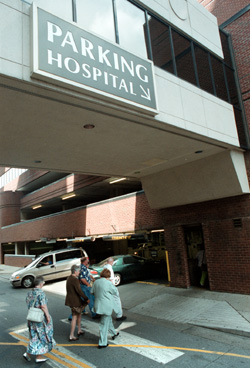
Beginning July 1, parking at the hospital garage will be free to all patients and their families. (photo by Dana Johnson)
Shortage of nurses looms as potential health crisis: study
America's pool of nurses is shrinking and according to a recent study, the total RN supply will fall 20 percent below projected requirements by 2020.
Within the next 10 to 20 years, the health care industry will be hit with a severe nursing shortage, according to a report published last week in the Journal of the American Medical Association by Peter I. Buerhaus, Ph.D., Vanderbilt University School of Nursing's Valere Potter Professor of Nursing and associate dean for Research.
"This is an emerging potential crisis," warns Buerhaus. "This is a major problem because it comes at a time when the nurse workforce is contracting and the 'baby boomer' group of nurses is aging.
"As the demand for health care increases at a high rate, the nurse workforce is decreasing, which creates a threat to the access and quality of health care," he said.
The study reports that the projected RN shortage is a "stark contrast to the oversupply expected by the Pew Health Professions Commission."
Buerhaus said this shortage is unlike previous shortages experienced in the nursing profession. He worries that nursing will not be able to attract enough people to meet the surging demand, despite expected wage increases.
"The coming RN shortage will be driven by fundamental, permanent shifts in the labor market that are unlikely to reverse in the next few years," according to the report.
"The forces driving this shortage are very clear. Addressing the problem is far more serious."
The study points to the expanding career opportunities for women as a reason for the decline in the numbers of young people entering the nursing workforce.
Another explanation for the projected shortage is directly linked to the rapid aging of the RN workforce.
"In 1980 and 1990, when these large cohorts were in their 20s and 30s, the RN workforce was dominated by young nurses, with over half of the workforce under age 40," reads the report.
"By the year 2000 … the 1950s cohorts are in their 40s and RNs of these ages dominate the workforce, outnumbering RNs in their 20s by nearly 4 to 1 (compared to 1980 when RNs in their 20s actually outnumbered RNs in their 40s).
"By 2010, the age distribution will have shifted as far as it will go (just before the 1950s nurses begin to retire), and over 40 percent of RNs are projected to be over age 50."
According to this report, the total number of RNs working full time is expected to peak near 2007.
Yet this number will decline steadily from that point on as the largest numbers of the workforce retire.
By 2020, the workforce is expected to be roughly the same size it is today — well below what health care officials project as required workforce levels.
In anticipation of these developments, the report urges both nursing administrators as well as policy makers to begin working on strategic plans to combat this trend.
"Addressing this problem will take the coordination of people from various arenas," he said. "The simple question of how to get more people interested in nursing is a tough one to tackle."
Buerhaus said the impetus for the study came after health care leaders from 11 states were surveyed about the nurse labor market.
Among the top concerns — the demographics of the nurse population and the significant impact it will have on the future of health care.
"This will affect everyone," Buerhaus said. "The consequence of the lack of staffing puts patient care at risk in all settings including acute care, home health care and physicians' offices.
"It will have a very broad and deep impact."
Others authors of the report include Douglas O. Staiger, Ph.D., associate professor of economics, Dartmouth College and the National Bureau of Economic Research, and David E. Auerbach, Ph.D., program in Health Policy, Harvard University and National Bureau of Economic Research.













